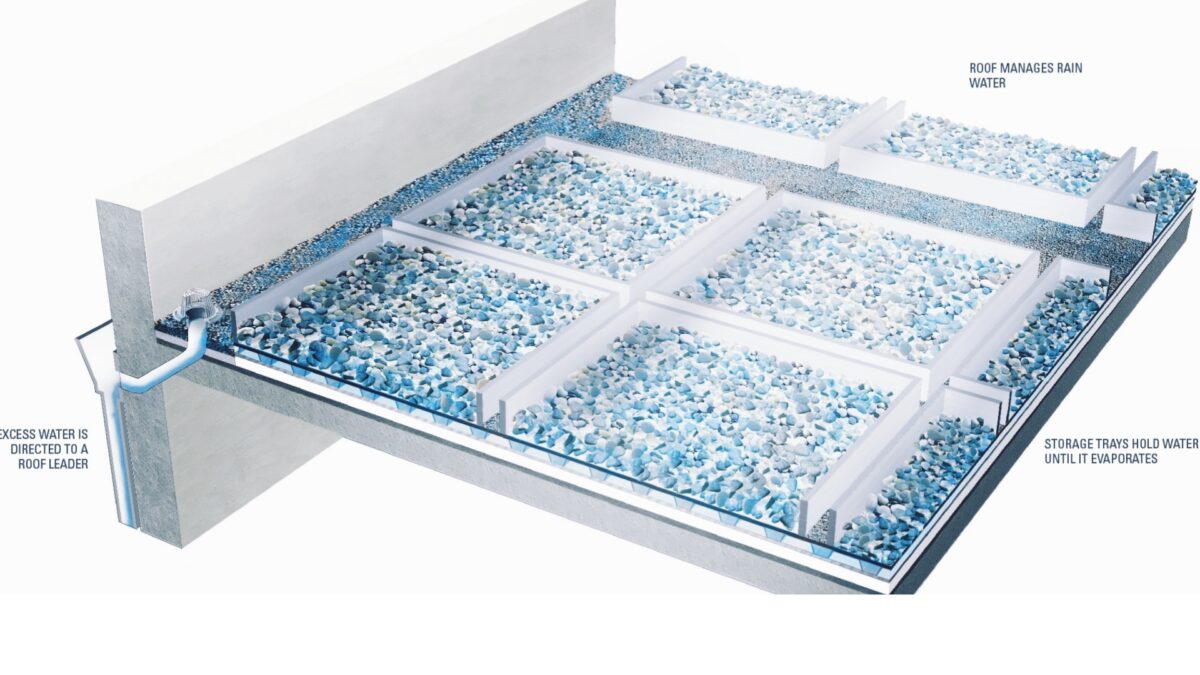Table of Contents
Blue Roof: Introduction
A blue roof is specifically designed to offer initial temporary water storage and gradual release of stored water, primarily rainfall. These roofs are constructed on flat or low sloped buildings in urban areas that face a risk of flooding due to a lack of permeable surfaces.

Water is stored in blue roof systems until it evaporates or is released downstream after the storm event has passed.
Blue roofs can be categorized as “active” or “passive” based on the control devices utilized to regulate water drainage from the roof.

They provide various benefits depending on their design, such as mitigating runoff impacts by temporarily storing rainfall, offering storage for reuse purposes like irrigation or cooling water makeup, and even creating recreational opportunities.
Types Of Blue Roofs
1. Active Blue Roof
Active blue roof systems utilize mechanical means to control the drainage rate of water from a rooftop. They are also known as automated roof runoff management systems. These systems employ valve configurations and controls to monitor and regulate the discharge of stormwater runoff from roofs. The water accumulated on the roof can be released in various ways, such as through a pneumatically or hydraulically actuated pinch valve, an electronically controlled valve connected to a timer, or manual valve operation.
2. Passive Blue Roof
Passive blue roof systems control the drainage rate of water from a rooftop using non-mechanical means. Unlike active systems that hinder water flow through drainage pipes, passive systems temporarily retain water on the roof’s surface by elongating the path it must follow to reach outlet drains. Blue roofs can include open water surfaces, storage within or beneath a porous media or modular surface, or beneath a raised decking surface or cover. These passive systems provide an alternative approach to managing stormwater runoff without relying on mechanical components.
Benefits Of Blue Roofs
- Blue roofs help manage stormwater by capturing and storing rainwater, preventing floods and protecting our communities.
- They save water by collecting rainwater that can be reused for things like watering plants and flushing toilets, helping us conserve our precious water resources.
- Blue roofs make buildings more energy efficient by providing insulation, which means we use less energy for heating and cooling our homes.
- They help keep cities cooler by absorbing and reflecting sunlight, making our neighborhoods more comfortable and reducing the heat island effect.
- Blue roofs help clean the air by acting as natural filters, trapping dust and pollutants and making our air cleaner and healthier to breathe.
- They create homes for plants, insects, and birds, adding to the diversity of wildlife in our urban areas and helping protect our environment.
- Blue roofs make buildings look beautiful with their green vegetation and water features, adding a touch of nature to our city landscapes.
- They reduce noise from busy streets and other noisy places, creating a quieter and more peaceful environment for everyone.
- Blue roofs make roofs last longer by providing extra protection against the sun’s rays and extreme weather, keeping our buildings strong and durable.
- They create rooftop gardens and recreational spaces where we can play, relax, and enjoy nature in the heart of the city, promoting a healthy and happy lifestyle.
Read also: Green Roof
